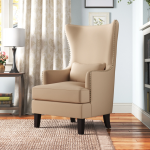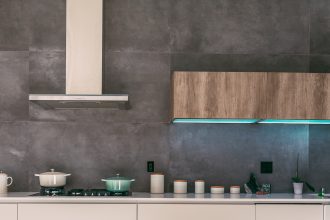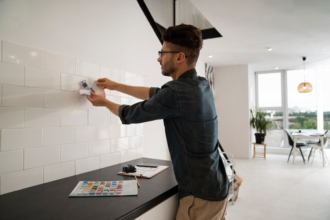Decorating is an interesting time. Whether you’re redecorating your living room or repurposing your spare room, the idea of being out with the old and in with the new is exciting. But it’s also a little nerve-wracking, and one of the main reasons for feeling anxiety during decorating is knowing where to start. But don’t worry, you don’t need to figure that out alone because we have the perfect answer to that tricky question. If you’ve ever wondered when decorating where do you start, we finally have the answers for you right here in this post!
1. Start with the floor-plan
The first thing you need to do when walking into a room you want to change is look at the floor-plan as it is right now. Is it working? Are there any areas with wasted space? Is it feeling too cramped or claustrophobic? Really focus on the feel of the room based on where everything is situated. Here is where you can also think about replacing any of the big pieces in a room – your seating arrangements, your bed, your storage, etc. Then reach for your notepad and pencil.
You don’t have to be an artist to sketch out a floor-plan that details the potential layout of a room. Just do a rough sketch and experiment with some ideas. It might take a little time, but you’ll eventually land on something that sticks. Remember, this is the very first thing you need to do when decorating, but that doesn’t mean it’s carved in stone. If you decide the couch looks better on the opposite wall when you get to the last few steps, move it. The floor-plan is just a guide to help set up the rest of the steps.
2. Think about colours and textures BEFORE buying new furniture
Yes, BEFORE you even think about the sofa you want or the new storage cabinet, you need to start with the basics. Colours are obvious. You need to have something to anchor everything else in the room and your colour scheme is usually the thing that does that best. Will you go neutral, bold, or somewhere in between?
Once you’ve settled on colours, don’t forget about textures. We see it all the time: people designing a wonderful new room with bright, beautiful colours and lots of liveliness and then the finished result just feels a little… flat? It’s usually because you haven’t thought about textures. You need different fabrics and materials to draw the eye. Your soft furnishings, such as cushions, blankets, rugs, and curtains, will help you achieve this. This step shouldn’t be skipped, even if you’re planning on redecorating an old room with just a lick of paint and some new cushions for the sofa – it’s still important.
3. Next up are the walls
Your walls are the place where you’ll get the most impact from decorating with the least amount of effort. Yes, changing out the big pieces such as sofas, beds, and wardrobes will have an effect, but not everybody wants to do this every time they redecorate. Some prefer a quick change just to freshen things up, and the walls should be where you look to achieve that.
They’re such wide open spaces you can do almost anything to them. Look for paintings, wall art, stencils – whatever your personal taste. It’s such a quick way to have an immediate impact on a room that sometimes you’ll feel content with the redecoration just because you’ve hung a new mirror and a nice painting.
Even if you’re doing a full redecoration project, the walls should be your next step. And we’re not even talking about reaching for the paint pots at this point. You will have already thought about the colours in the previous step, but don’t be tempted into buying the paint and starting in case you can’t find things to hang on your wall that match. Sometimes people will decorate an entire room around a painting that they love, so be prepared to have your head turned towards other options as you shop for wall art. This is OK, it’s all part of the process, but it’s also why you shouldn’t waste time painting the walls yet, in case you’re led down a different path.
4. Choose decor (but don’t put it in place yet)
Choosing your decor is sort of the same process as the walls, but on a smaller scale. You’ll know what free areas you have to add some decoration because of your floor plan. Maybe you need a plant for your coffee table, or an ornament for the fireplace. Whatever it is, now is the time to think about those small decor pieces that really tie a room together.
But don’t place them yet, because we’re about to make a bit of a mess…
5. Decorate your room
By ‘decorate’, we mean the big stuff. Now is the time to reach for your spare clothes and overalls and get stuck in. If you are getting new flooring laid by professionals, get them here ASAP. If you’re reaching for the paintbrush yourself, then tie back your hair and get going. This is the last big push before we get all the furniture back into the room.
It goes without saying, but if you are getting new flooring, then it makes sense to paint the walls, ceiling, and skirting boards before you get the new flooring down. That way, you won’t have any drips of paint finding their way to your new hardwood floors. If you’re keeping the old flooring, then put down some covers and get to work. Only remove the protective covers after the paint is fully dry to the touch.
Always start with the walls, then ceiling, then skirting boards when painting, because it’ll mean you have less ‘touching up’ to do to fix any little mistakes where the wrong coloured paint has made its way to a part of the wall it shouldn’t be on.
6. Position your ‘statement pieces’
Wait until all the paint is dry and the new flooring has settled, and then bring in the ‘statement pieces’. These are the big pieces of furniture that can’t be moved easily. Look back at your floor-plan and decide if it still works. If it doesn’t, then think of something else. It’ll be much easier to see what works and what doesn’t when you get the big statement pieces into position.
Leave the decor and wall art for now. Yes, you will have purchased everything by this point, but just get the bare essentials in. Perhaps even leave the smaller pieces out for a few days whilst you test out the new layout to see if it works. That way, there’s less to move if you change your mind.
7. Finishing off
Once you’re satisfied with everything, then you can bring in the decor, the wall art, and all the soft furnishings that aren’t in place yet. This is when a room becomes something special. By now you should be pretty happy with your decorating, and if you’re not… Well, back to step one you go, because it’s time to do it all again!
If you’ve ever wondered ‘When decorating where do you start?’, then we hope this guide has cleared things up for you. If you take decorating and break it down into logical steps like the ones we’ve provided, you not only make the task more manageable, but you also guarantee that you won’t miss a little step that could throw off the entire decoration process. Stick to this plan, and you won’t go wrong!














